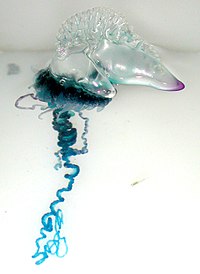
Photo from wikipedia
Abstract Density functional theory (DFT) calculations were conducted to investigate the cobalt porphyrin‐catalyzed electro‐reduction of CO2 to CO in an aqueous solution. The results suggest that CoII−porphyrin (CoII−L) undertakes a… Click to show full abstract
Abstract Density functional theory (DFT) calculations were conducted to investigate the cobalt porphyrin‐catalyzed electro‐reduction of CO2 to CO in an aqueous solution. The results suggest that CoII−porphyrin (CoII−L) undertakes a ligand‐based reduction to generate the active species CoII−L⋅−, where the CoII center antiferromagnetically interacts with the ligand radical anion. CoII−L⋅− then performs a nucleophilic attack on CO2, followed by protonation and a reduction to give CoII−L−COOH. An intermolecular proton transfer leads to the heterolytic cleavage of the C−O bond, producing intermediate CoII−L−CO. Subsequently, CO is released from CoII−L−CO, and CoII−L is regenerated to catalyze the next cycle. The rate‐determining step of this CO2RR is the nucleophilic attack on CO2 by CoII−L⋅−, with a total barrier of 20.7 kcal mol−1. The competing hydrogen evolution reaction is associated with a higher total barrier. A computational investigation regarding the substituent effects of the catalyst indicates that the CoPor−R3 complex is likely to display the highest activity and selectivity as a molecular catalyst.
Journal Title: ChemistryOpen
Year Published: 2023
Link to full text (if available)
Share on Social Media: Sign Up to like & get
recommendations!